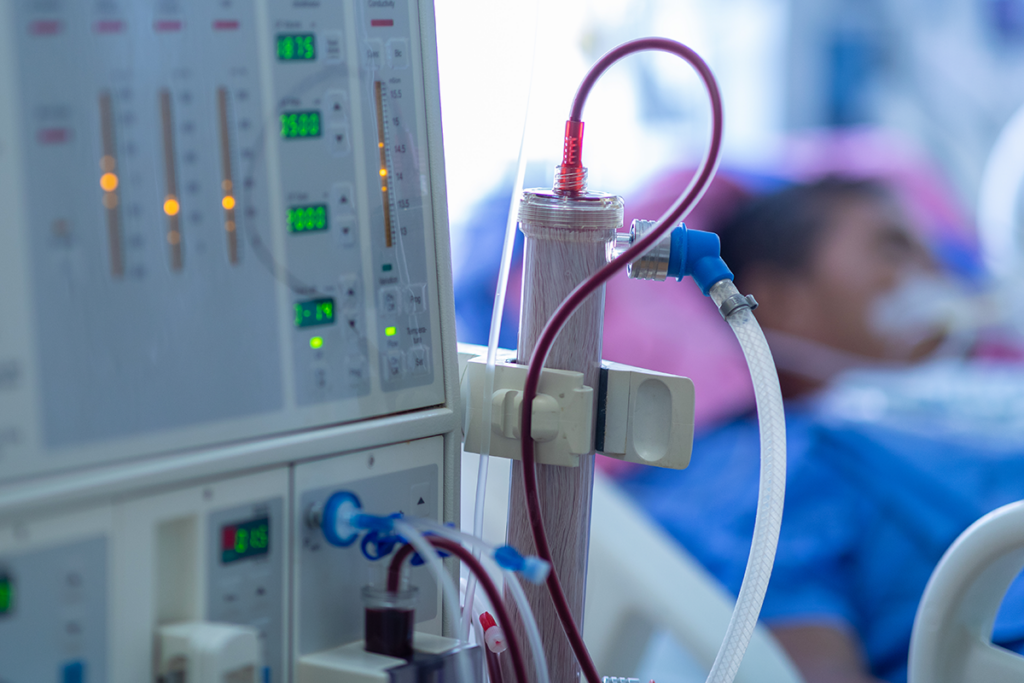Schaeffer Clinical Fellow Eugene Lin finds dialysis facilities owned by nephrologists may provide better care. A second study evaluates the timing of dialysis and elective surgeries, finding days can make a big difference in post-surgery outcomes for patients.
In the U.S., dialysis is a costly treatment with poor health outcomes. According to the CDC, 15% of adults—37 million people—have chronic kidney disease. As the disease progresses to end-stage kidney disease, patients are required to receive dialysis regularly or have a kidney transplant. Although dialysis is lifesaving in the short-term, five-year mortality rates exceed 60%.
Eugene Lin, senior fellow at the USC Schaeffer Center for Health Policy & Economics and assistant professor of nephrology at the Keck School of Medicine of USC, is conducting research to improve the way we think about dialysis care and the outcomes for patients.
“Dialysis is unique because it is the only disease-qualifying condition for Medicare. Because it is a multibillion-dollar industry that impacts a disproportionate portion of Medicare spending, understanding the policies that affect the provision of dialysis and downstream outcomes is critical,” said Lin.
In studies published in November 2022, Lin and his colleagues analyze two distinct aspects of dialysis and their effect on patient outcomes: Ownership of dialysis facilities and timing of dialysis and surgery.
Dialysis facilities owned by kidney doctors may provide better care
Clinics that are entirely or partially owned by nephrologists represent an increasing share of dialysis facilities. Unlike nephrologists that do not have an ownership stake in a dialysis clinic, physician owners can directly profit from the types of treatments they recommend. But they may also have more autonomy in terms of clinical decisions.
In a study published in JAMA Internal Medicine, Lin and his colleagues analyzed data from fee-for-service Medicare patients receiving dialysis for end-stage kidney disease from January to November in 2017. The researchers compared outcomes between patients managed by physician owners and patients managed by non-owners within clinics owned by physicians.
Patients treated by physician-owners were approximately 25% more likely to receive home dialysis care. They were also less likely to use erythropoietin-stimulating agents (ESAs), which are expensive medications that are used to treat anemia in patients with end-stage kidney disease. Strikingly, less use of these drugs was not associated with worse patient outcomes with no difference in blood transfusions.
On measures of missed appointments, transplant wait lists, deaths, hospitalizations or long-term catheter use, the researchers find physician owners performed no better or worse than non-physician owner clinics.
“It may be that dialysis clinics that are owned by nephrologists develop different clinical guidelines—they may be better equipped to build successful home dialysis programs or develop more sophisticated triggers for anemia so that they do not have to prescribe these drugs as often,” explained Lin.
Sign up for Schaeffer Center news
“We had thought that the financial conflict of interest stemming from clinic ownership would lead to potentially worse outcomes for patients,” Lin said. “This doesn’t seem to happen. However, our study was limited to a cross-sectional analysis of 2017 data. We need better transparency of financial relationships across the entire dialysis industry, so that policymakers can conduct more robust studies of these conflicts of interest.”
A shorter interval between dialysis and surgery may improve post-surgery survival
The optimal timing for having dialysis prior to elective surgery is unknown. But these patients have an increased risk of post-operative mortality, heart attack, stroke sepsis and surgical site infection and the timing of when they receive dialysis may play an important role.
In the second study, published in JAMA, Lin and colleagues analyze data on 90-day post operative mortality for end-stage kidney patients 18 years of age and older who underwent elective surgery from 2011 to 2018. Of the 1.1 million surgical procedures included in the data, 65% of procedures had a 1-day interval between dialysis and surgery while 36% of procedures had either a 2 or 3-day interval. For 16.6% of procedures, dialysis was performed on the day of the surgery.
The researchers find longer intervals between dialysis and surgery were associated with a higher risk of post-operative mortality. For example, among patients with a 3-day interval, the mortality risk was 5.2% compared to 4.2% for patients with 1-day interval. Yet, having dialysis treatment on the day of the surgery erased the increased risk.
“Given our findings, doctors and hospitals should consider scheduling surgeries around dialysis or, when that is not possible, perform dialysis right before the surgery,” said Lin, who was the senior author on this study.
The researchers note that while the risk difference was small – and many of the procedures included in the study were relatively minor- patients with end-stage kidney disease undergo a lot of procedures and generally face worse outcomes, so even small changes in the absolute risk could be meaningful.
Policy implications
Given the resources required for dialysis and the poor health outcomes experienced by patients with end-stage kidney disease, Lin suggests that policymakers and stakeholders consider a number of policy changes.
- Improved data transparency would allow researchers to better understand whether financial incentives and ownership are impacting patient outcomes. Regardless of physician-ownership status, several recent studies conducted by researchers at the Schaeffer Center have identified aspects of the dialysis market that are leading to increased spending.
- CMS could establish quality metrics on post-operative outcomes for patients with end-stage kidney disease undergoing surgery or on the scheduling of elective surgeries.
“Ultimately, I hope these projects facilitate improvements in dialysis delivery, so that patients on dialysis receive the best possible care,” Lin said.
In addition to Lin, the JAMA Internal Medicine study was coauthored by Matthew S McCoy of the University of Pennsylvania, Manqing Liu of Harvard University, Khristina Lung of the USC Schaeffer Center, Derick Rapista of the USC Schaeffer Center and the Margolis Center for Health Policy, Jeffrey S. Berns of the University of Pennsylvania and Genevieve Kanter of the USC Schaeffer Center and the University of Pennsylvania. The research was funded in part by the National Institute of Diabetes and Digestive and Kidney Diseases (NIDDK) (award number K08 DK118213), the University Kidney Research Organization and the Leonard Davis Institute of Health Economics at the University of Pennsylvania.
The JAMA study was coauthored by Vikram Fielding-Singh and Matthew Vanneman of Stanford University, Tristan Grogan and Jacques Neelankavil of the University of California Los Angeles, Wolfgang C. Winkelmayer of Baylor College of Medicine, Tara I. Chang of Stanford University, and Vincent Liu of Kaiser Permanente. The research was funded in party by the Department of Anesthesiology and Perioperative Medicine, University of California, Los Angeles, the Department of Anesthesiology, Perioperative, and Pain Medicine, School of Medicine, Stanford University, the National Institute of General Medical Sciences (award number R35GM128672), the National Institute of Diabetes and Digestive and Kidney Diseases (NIDDK) (award number K08 DK118213), and the American Society of Nephrology.
Related Work
-
Perspective
Policy Issues in Dialysis Care
-
Journal Articles
Conflicts of Interest in Dialysis: A Barrier to Policy Reforms




